Observed and Potential Impacts of the COVID-19 Pandemic on the Environment
Abstract
1. Introduction
2. Methods
3. COVID-19 and Other Large-Scale Epidemic Diseases of the 21st Century
- The Severe Acute Respiratory Syndrome (SARS) occurred in 2003, leading to more than 8000 infections with a mortality rate of approximately 10% and an impact limited only to local and regional economies [28]. The epidemic ended abruptly in July 2003 and no human cases of the SARS coronavirus have been detected since.
- The 2009 H1N1 influenza virus (swine flu) was a pandemic which first appeared in Mexico and the United States in March and April of 2009. It became a global pandemic as a result of global mobility and airline travel and led to an estimated 0.4% case fatality [29].
- Middle East respiratory syndrome (MERS) was first identified in humans in Saudi Arabia and Jordan in 2012 [30]. MERS is considered a zoonotic pathogen, with infected dromedary camels being the animal source of infection to humans [31,32]. By contrast to SARS, which was contained within a year of emerging, MERS continues to have a limited circulation and causes human disease with intermittent sporadic cases, community clusters and nosocomial outbreaks in the Middle East region with a high risk of spreading globally [33].
- The Ebola virus was first detected in 1976 in Zaire (presently the Democratic Republic of Congo). Since the virus was first detected, over 20 known outbreaks of Ebola have been identified in sub-Saharan Africa, mostly in Sudan, Uganda, Democratic Republic of Congo and Gabon [34]. At present, no vaccine or efficient antiviral management strategy exists for Ebola [35]. Although the Ebola virus has substantial epidemic and pandemic potential (due to the ease of international travel), as shown by the 2013–2016 West-African Ebola virus epidemic with approximately 28,000 confirmed cases and 11,000 deaths [36,37], Ebola outbreaks have been geographically limited [34].
- The Zika fever (2015–2016) was first isolated in 1947 from a febrile rhesus macaque monkey in the Zika Forest of Uganda. Since 1954, when the first cases in humans were reported, the Zika virus had only limited sporadic infections in Africa and Asia. However, a large outbreak with approximately 440,000 to 1,300,000 cases spread from Brazil to 29 countries in the Americas in 2015 [38]. In November 2016, WHO announced the end of the Zika outbreak.
4. Impacts on the Environment
4.1. Impacts on the Physical Systems of the Environment
4.1.1. Air Quality and Local Climate
4.1.2. Aquatic Systems and Water Resources
4.1.3. The Soil Environment
4.2. Impacts on the Ecological Systems
4.3. Impacts on Environmental Dimension of the Global Affairs
4.4. Environmental Monitoring and Climate Services
5. Impacts on the Present Climate and Climate Change
6. Conclusions
Supplementary Materials
Author Contributions
Funding
Acknowledgments
Conflicts of Interest
References
- Johnston, A.S.; Boyd, R.J.; Watson, J.W.; Paul, A.; Evans, L.C.; Gardner, E.; Boult, V. Predicting population responses to environmental change from individual-level mechanisms: Towards a standardized mechanistic approach. Proc. R. Soc. B 2019, 286, 20191916. [Google Scholar] [CrossRef] [PubMed]
- Cremades, R.; Mitter, H.; Tudose, N.C.; Sanchez-Plaza, A.; Graves, A.; Broekman, A.; Bender, S.; Giupponi, C.; Koundouri, P.; Bahri, M.; et al. Ten principles to integrate the water-energy-land nexus with climate services for co-producing local and regional integrated assessments. Sci. Total Environ. 2019, 693, 133662. [Google Scholar] [CrossRef] [PubMed]
- Field, C.B.; Barros, V.; Stocker, T.F.; Dahe, Q. Managing the Risks of Extreme Events and Disasters to Advance Climate Change Adaptation: Special Report of the Intergovernmental Panel on Climate Change; Cambridge University Press: Cambridge, UK, 2012; ISBN 1-107-02506-0. [Google Scholar]
- Zibulewsky, J. Defining Disaster: The Emergency Department Perspective; Taylor & Francis: Oxfordshire, UK, 2001; Volume 14, pp. 144–149. [Google Scholar]
- Perry, R.W. Defining disaster: An evolving concept. In Handbook of Disaster Research; Springer: Berlin/Heidelberg, Germany, 2018; pp. 3–22. [Google Scholar]
- Ripoll Gallardo, A.; Pacelli, B.; Alesina, M.; Serrone, D.; Iacutone, G.; Faggiano, F.; Della Corte, F.; Allara, E. Medium-and long-term health effects of earthquakes in high-income countries: A systematic review and meta-analysis. Int. J. Epidemiol. 2018, 47, 1317–1332. [Google Scholar] [CrossRef] [PubMed]
- Madhav, N.; Oppenheim, B.; Gallivan, M.; Mulembakani, P.; Rubin, E.; Wolfe, N. Pandemics: Risks, impacts, and mitigation. In Disease Control Priorities: Improving Health and Reducing Poverty, 3rd ed.; The International Bank for Reconstruction and Development: Washington, DC, USA; The World Bank: Washington, DC, USA, 2017. [Google Scholar]
- Cucinotta, D.; Vanelli, M. WHO declares COVID-19 a pandemic. Acta Bio-Medica Atenei Parm. 2020, 91, 157–160. [Google Scholar] [CrossRef]
- WHO Director-General’s Opening Remarks at the Media Briefing on COVID-19–30 March 2020. Available online: https://www.who.int/dg/speeches/detail/who-director-general-s-opening-remarks-at-the-media-briefing-on-covid-19---30-march-2020 (accessed on 11 May 2020).
- Coronavirus. Available online: https://www.who.int/emergencies/diseases/novel-coronavirus-2019 (accessed on 11 May 2020).
- Ferretti, L.; Wymant, C.; Kendall, M.; Zhao, L.; Nurtay, A.; Abeler-Dörner, L.; Parker, M.; Bonsall, D.; Fraser, C. Quantifying SARS-CoV-2 transmission suggests epidemic control with digital contact tracing. Science 2020, 368. [Google Scholar] [CrossRef] [PubMed]
- United Nations Development Programme. Human Development Indicators and Indices: 2018 Statistical Update Team. Available online: http://hdr.undp.org/sites/default/files/2018_human_development_statistical_update.pdf (accessed on 11 May 2020).
- Cornwall, W. Can you put a price on COVID-19 options? Experts weigh lives versus economics. Science 2020, 10. [Google Scholar] [CrossRef]
- Erdmann, G. Transition from Democracy-Loss of Quality, Hybridisation and Breakdown of Democracy; GIGA Working Paper No. 161; GIGA Working Paper: Berlin, Germany, 6 April 2011. [Google Scholar]
- Hirst, W.; Phelps, E.A.; Buckner, R.L.; Budson, A.E.; Cuc, A.; Gabrieli, J.D.; Johnson, M.K.; Lustig, C.; Lyle, K.B.; Mather, M. Long-term memory for the terrorist attack of September 11: Flashbulb memories, event memories, and the factors that influence their retention. J. Exp. Psychol. Gen. 2009, 138, 161. [Google Scholar] [CrossRef] [PubMed]
- Ilardi, G.J. The 9/11 attacks—A study of Al Qaeda’s use of intelligence and counterintelligence. Stud. Confl. Terror. 2009, 32, 171–187. [Google Scholar] [CrossRef]
- Loveless, M. The deterioration of democratic political culture: Consequences of the perception of inequality. Soc. Justice Res. 2013, 26, 471–491. [Google Scholar] [CrossRef]
- McCoy, J. Tahmina rahman, and Murat Somer. Polarization and the global crisis of democracy: Common patterns, dynamics, and pernicious consequences for democratic polities. Am. Behav. Sci. 2018, 62, 16–42. [Google Scholar] [CrossRef]
- Nicola, M.; Alsafi, Z.; Sohrabi, C.; Kerwan, A.; Al-Jabir, A.; Iosifidis, C.; Agha, M.; Agha, R. The Socio-Economic Implications of the Coronavirus and COVID-19 Pandemic: A Review. Int. J. Surg. 2020, 78, 185–193. [Google Scholar] [CrossRef] [PubMed]
- Scouras, J. Nuclear war as a global catastrophic risk. J. Benefit-Cost Anal. 2019, 10, 274–295. [Google Scholar] [CrossRef]
- Spiegel, M. The academic analysis of the 2008 financial crisis: Round 1. Rev. Financ. Stud. 2011, 24, 1773–1781. [Google Scholar] [CrossRef]
- Toon, O.B.; Bardeen, C.G.; Robock, A.; Xia, L.; Kristensen, H.; McKinzie, M.; Peterson, R.; Harrison, C.S.; Lovenduski, N.S.; Turco, R.P. Rapidly expanding nuclear arsenals in Pakistan and India portend regional and global catastrophe. Sci. Adv. 2019, 5, eaay5478. [Google Scholar] [CrossRef] [PubMed]
- Wiesner, K.; Birdi, A.; Eliassi-Rad, T.; Farrell, H.; Garcia, D.; Lewandowsky, S.; Palacios, P.; Ross, D.; Sornette, D.; Thébault, K. Stability of democracies: A complex systems perspective. Eur. J. Phys. 2018, 40, 014002. [Google Scholar] [CrossRef]
- Ali, I.; Alharbi, O.M. COVID-19: Disease, management, treatment, and social impact. Sci. Total Environ. 2020, 138861. [Google Scholar] [CrossRef]
- Harapan, H.; Itoh, N.; Yufika, A.; Winardi, W.; Keam, S.; Te, H.; Megawati, D.; Hayati, Z.; Wagner, A.L.; Mudatsir, M. Coronavirus disease 2019 (COVID-19): A literature review. J. Infect. Public Health 2020. [Google Scholar] [CrossRef] [PubMed]
- Cramer, W.; Yohe, G.; Auffhammer, M.; Huggel, C.; Molau, U.; Dias, M.A.S.; Bouwer, L.; Carey, M.; Coumou, D.; Hansen, G. Detection and Attribution of Observed Impacts; Cambridge University Press: Cambridge, UK, 2014; Volume 18, p. 1. [Google Scholar]
- Woolhouse, M.E.; Gowtage-Sequeria, S. Host range and emerging and reemerging pathogens. Emerg. Infect. Dis. 2005, 11, 1842. [Google Scholar] [CrossRef] [PubMed]
- LeDuc, J.W.; Barry, M.A. SARS, the first pandemic of the 21st century. Emerg. Infect. Dis. 2004, 10, e26. [Google Scholar] [CrossRef]
- Al Hajjar, S.; McIntosh, K. The first influenza pandemic of the 21st century. Ann. Saudi Med. 2010, 30, 1–10. [Google Scholar] [CrossRef] [PubMed]
- Memish, Z.A.; Perlman, S.; Van Kerkhove, M.D.; Zumla, A. Middle East respiratory syndrome. Lancet 2020. [Google Scholar] [CrossRef]
- El-Kafrawy, S.A.; Corman, V.M.; Tolah, A.M.; Al Masaudi, S.B.; Hassan, A.M.; Müller, M.A.; Bleicker, T.; Harakeh, S.M.; Alzahrani, A.A.; Alsaaidi, G.A. Enzootic patterns of Middle East respiratory syndrome coronavirus in imported African and local Arabian dromedary camels: A prospective genomic study. Lancet Planet. Health 2019, 3, e521–e528. [Google Scholar] [CrossRef]
- Gardner, E.G.; Kelton, D.; Poljak, Z.; Van Kerkhove, M.; Von Dobschuetz, S.; Greer, A.L. A case-crossover analysis of the impact of weather on primary cases of Middle East respiratory syndrome. BMC Infect. Dis. 2019, 19, 113. [Google Scholar] [CrossRef] [PubMed]
- Zumla, A.; Hui, D.S.; Perlman, S. Middle East respiratory syndrome. Lancet 2015, 386, 995–1007. [Google Scholar] [CrossRef]
- Malvy, D.; McElroy, A.K.; De Clerck, H.; Günther, S.; Van Griensven, J. Ebola virus disease. Lancet 2019. [Google Scholar] [CrossRef]
- Hasan, S.; Ahmad, S.A.; Masood, R.; Saeed, S. Ebola virus: A global public health menace: A narrative review. J. Fam. Med. Prim. Care 2019, 8, 2189. [Google Scholar]
- Garske, T.; Cori, A.; Ariyarajah, A.; Blake, I.M.; Dorigatti, I.; Eckmanns, T.; Fraser, C.; Hinsley, W.; Jombart, T.; Mills, H.L. Heterogeneities in the case fatality ratio in the West African Ebola outbreak 2013–2016. Philos. Trans. R. Soc. B Biol. Sci. 2017, 372, 20160308. [Google Scholar] [CrossRef] [PubMed]
- Lo, T.Q.; Marston, B.J.; Dahl, B.A.; De Cock, K.M. Ebola: Anatomy of an epidemic. Annu. Rev. Med. 2017, 68, 359–370. [Google Scholar] [CrossRef] [PubMed]
- Plourde, A.R.; Bloch, E.M. A literature review of Zika virus. Emerg. Infect. Dis. 2016, 22, 1185. [Google Scholar] [CrossRef] [PubMed]
- Alexander, D.J.; Brown, I.H. History of highly pathogenic avian influenza. Rev. Sci Tech. 2009, 28, 19–38. [Google Scholar] [CrossRef] [PubMed]
- Chatziprodromidou, I.P.; Arvanitidou, M.; Guitian, J.; Apostolou, T.; Vantarakis, G.; Vantarakis, A. Global avian influenza outbreaks 2010–2016: A systematic review of their distribution, avian species and virus subtype. Syst. Rev. 2018, 7, 17. [Google Scholar] [CrossRef] [PubMed]
- Liu, J.; Zhou, J.; Yao, J.; Zhang, X.; Li, L.; Xu, X.; He, X.; Wang, B.; Fu, S.; Niu, T. Impact of meteorological factors on the COVID-19 transmission: A multi-city study in China. Sci. Total Environ. 2020, 138513. [Google Scholar] [CrossRef] [PubMed]
- Zhu, Y.; Xie, J. Association between ambient temperature and COVID-19 infection in 122 cities from China. Sci. Total Environ. 2020, 138201. [Google Scholar] [CrossRef] [PubMed]
- Sagripanti, J.-L.; Lytle, C.D. Inactivation of influenza virus by solar radiation. Photochem. Photobiol. 2007, 83, 1278–1282. [Google Scholar] [CrossRef] [PubMed]
- Rohde, R. The Relationship between Coronavirus (COVID-19) Spread and the Weather; Berkeley Earth: Berkeley, CA, USA, 2020. [Google Scholar]
- L’Italia un modello? Certo, da non seguire. Available online: https://www.lanuovabq.it/it/litalia-un-modello-certo-da-non-seguire (accessed on 11 May 2020).
- Horowitz, J.; Bubola, E.; Povoledo, E. Italy, Pandemic’s New Epicenter, Has Lessons for the World. N. Y. Times 2020, 21. [Google Scholar]
- Nations, U. The recovery from the COVID-19 crisis must lead to a different economy. Available online: https://www.un.org/en/un-coronavirus-communications-team/launch-report-socio-economic-impacts-covid-19 (accessed on 11 May 2020).
- Haass, R. The Pandemic Will Accelerate History Rather Than Reshape It. Available online: https://www.foreignaffairs.com/articles/united-states/2020-04-07/pandemic-will-accelerate-history-rather-reshape-it (accessed on 15 April 2020).
- UNCTAD | NewsDetails. Available online: https://unctad.org/en/pages/newsdetails.aspx?OriginalVersionID=2333 (accessed on 11 May 2020).
- Emissions of the main air pollutants in Europe. Available online: https://www.eea.europa.eu/data-and-maps/indicators/main-anthropogenic-air-pollutant-emissions/assessment-6 (accessed on 11 May 2020).
- Coronavirus Impact Index by Industry | Computer Economics—For IT Metrics, Ratios, Benchmarks, and Research Advisories for IT Management. Available online: https://www.computereconomics.com/article.cfm?id=2788 (accessed on 11 May 2020).
- Tracking the Global Impact of the Coronavirus Outbreak. Available online: https://www.bain.com/insights/tracking-the-global-impact-of-the-coronavirus-outbreak-snap-chart/ (accessed on 11 May 2020).
- Tollefson, J. Climate vs coronavirus: Why massive stimulus plans could represent missed opportunities. Nature 2020. [Google Scholar] [CrossRef]
- Setti, L.; Passarini, F.; De Gennaro, G.; Di Gilio, A.; Palmisani, J.; Buono, P.; Fornari, G.; Perrone, M.; Pizzalunga, A.; Barbieri, P. Position Paper Relazione Circa L’effetto Dell’inquinamento da Particolato Atmosferico e la Diffusione di Virus Nella Popolazione; SIMA-Società Italiana di Medicina Ambientale: Milano, Italy, 2020; Volume 2020. [Google Scholar]
- Home | State of Global Air. Available online: https://www.stateofglobalair.org/ (accessed on 11 May 2020).
- Contini, D.; Costabile, F. Does Air Pollution Influence COVID-19 Outbreaks? Atmosphere 2020, 11, 377. [Google Scholar] [CrossRef]
- Lewis, D. Is the coronavirus airborne? Experts can’t agree. Nature 2020, 580, 175. [Google Scholar] [CrossRef] [PubMed]
- Meselson, M. Droplets and Aerosols in the Transmission of SARS-CoV-2. N. Engl. J. Med. 2020. [Google Scholar] [CrossRef]
- Schwartz, K.L.; Murti, M.; Finkelstein, M.; Leis, J.; Fitzgerald-Husek, A.; Bourns, L.; Meghani, H.; Saunders, A.; Allen, V.; Yaffe, B. Lack of COVID-19 Transmission on an International Flight. Available online: https://www.cmaj.ca/content/lack-covid-19-transmission-international-flight (accessed on 20 April 2020).
- Salute, R.I.A. e Inquinamento atmosferico e COVID-19. Available online: https://www.scienzainrete.it/articolo/inquinamento-atmosferico-e-covid-19/rete-italiana-ambiente-e-salute/2020-04-13 (accessed on 11 May 2020).
- Nancy Binkin. Available online: https://www.scienzainrete.it/autori/binkin/2422 (accessed on 11 May 2020).
- Forastiere, F.; Bonifazi, F. Mascherine per tutti? Available online: https://www.scienzainrete.it/articolo/mascherine-tutti/francesco-forastiere-floriano-bonifazi/2020-04-06 (accessed on 11 May 2020).
- Harrison, R.M.; Masiol, M.; Vardoulakis, S. Civil aviation, air pollution and human health. Environ. Res. Lett. 2015, 10, 041001. [Google Scholar] [CrossRef]
- Kivits, R.; Charles, M.B.; Ryan, N. A post-carbon aviation future: Airports and the transition to a cleaner aviation sector. Futures 2010, 42, 199–211. [Google Scholar] [CrossRef]
- Remarks of Alexandre de Juniac at the IATA Media Briefing on COVID-19. 21 April 2020. Available online: https://www.iata.org/en/pressroom/speeches/2020-04-21-01/ (accessed on 11 May 2020).
- Travis, D.J.; Carleton, A.M.; Lauritsen, R.G. Contrails reduce daily temperature range. Nature 2002, 418, 601. [Google Scholar] [CrossRef] [PubMed]
- Bock, L.; Burkhardt, U. Contrail cirrus radiative forcing for future air traffic. Atmospheric Chem. Phys. ACP 2019, 8163–8174. [Google Scholar] [CrossRef]
- Treibhausgase. Available online: https://www.umweltbundesamt.at/umweltsituation/luft/treibhausgase/ (accessed on 11 May 2020).
- Online, W.Z. Verkehr in Wien halbiert. Available online: https://www.wienerzeitung.at/nachrichten/chronik/wien/2056903-Verkehr-in-Wien-halbiert.html (accessed on 11 May 2020).
- Air Pollution Goes down as Europe Takes Hard Measures to Combat Coronavirus. Available online: https://www.eea.europa.eu/highlights/air-pollution-goes-down-as (accessed on 11 May 2020).
- Tobías, A.; Carnerero, C.; Reche, C.; Massagué, J.; Via, M.; Minguillón, M.C.; Alastuey, A.; Querol, X. Changes in air quality during the lockdown in Barcelona (Spain) one month into the SARS-CoV-2 epidemic. Sci. Total Environ. 2020, 138540. [Google Scholar] [CrossRef] [PubMed]
- Milano 2020 Strategia di adattamento. Available online: https://www.comune.milano.it/documents/20126/95930101/Milano+2020.++Strategia+di+adattamento.pdf/c96c1297-f8ad-5482-859c-90de1d2b76cb?t=1587723749501 (accessed on 26 April 2020).
- Medema, G.; Heijnen, L.; Elsinga, G.; Italiaander, R.; Brouwer, A. Presence of SARS-Coronavirus-2 in sewage. MedRxiv 2020. [Google Scholar] [CrossRef]
- COVID19-Water-Fact-Sheet.pdf. Available online: https://watereuse.org/wp-content/uploads/2020/04/COVID19-Water-Fact-Sheet.pdf (accessed on 11 May 2020).
- Gundy, P.M.; Gerba, C.P.; Pepper, I.L. Survival of coronaviruses in water and wastewater. Food Environ. Virol. 2009, 1, 10. [Google Scholar] [CrossRef]
- How Covid-19 impacts water consumption | Aquatech. Available online: https://www.aquatechtrade.com/news/utilities/covid-19-lockdowns-impact-water-consumption/ (accessed on 11 May 2020).
- ZEIT ONLINE | Lesen Sie zeit.de mit Werbung oder imPUR-Abo. Sie haben die Wahl. Available online: https://www.zeit.de/zustimmung?url=https%3A%2F%2Fwww.zeit.de%2Fgesellschaft%2F2020-04%2Fcorona-alltag-konsum-stromverbrauch-wasserverbrauch-schlafverhalten-grafiken (accessed on 11 May 2020).
- Duschen, kochen, Pflanzen gießen: Wie sich unser Wasserverbrauch in Corona-Zeiten verändert. Available online: https://www.watson.de/!655614316 (accessed on 11 May 2020).
- 20-04-02_Artikel_ORF_-_Coronavirus_veraendert_den_Wasserverbrauch.pdf. Available online: https://www.wassertirol.at/fileadmin/user_upload/Service/News/2020/20-04-02_Artikel_ORF_-_Coronavirus_veraendert_den_Wasserverbrauch.pdf (accessed on 11 May 2020).
- 20-03-22_Artikel_ORF_-_CoV_Fuenf_Prozent_mehr_Wasserverbrauch.pdf. Available online: https://www.wassertirol.at/fileadmin/user_upload/Service/News/2020/20-03-22_Artikel_ORF_-_CoV_Fuenf_Prozent_mehr_Wasserverbrauch.pdf (accessed on 11 May 2020).
- Čenčur Curk, B.; Cheval, S.; Vrhovnik, P.; Verbovšek, T.; Herrnegger, M.; Nachtnebel, H.; Marjanović, P.; Siegel, H.; Gerhardt, E.; Hochbichler, E. CC-WARE Mitigating Vulnerability of Water Resources under Climate Change. WP3-Vulnerability of Water Resources in SEE.–Report Version 5; Technical Report; Austrian Federal Ministry of Agriculture, Forestry, Environment and Water Management, Forest Department (AT): Vienna, Austria, November 2014.
- Čenčur Curk, B.; Vrhovnik, P.; Verbovsek, T.; Dimkic, D.; Marjanovic, P.; Tahy, A.; Simonffy, Z.; Corsini, A.; Nistor, M.; Cheval, S. Vulnerability of Water Resources to Climate Change in South-East Europe. In Proceedings of the AQUA 2015, 42nd IAH Congress, Rome, Italy, 13–18 September 2015; The International Association of Hydrogeologists: London, UK. [Google Scholar]
- United Nations Official Document. Available online: https://www.un.org/ga/search/view_doc.asp?symbol=A/RES/70/1&Lang=E (accessed on 11 May 2020).
- Van Doremalen, N.; Bushmaker, T.; Morris, D.H.; Holbrook, M.G.; Gamble, A.; Williamson, B.N.; Tamin, A.; Harcourt, J.L.; Thornburg, N.J.; Gerber, S.I. Aerosol and surface stability of SARS-CoV-2 as compared with SARS-CoV-1. N. Engl. J. Med. 2020, 382, 1564–1567. [Google Scholar] [CrossRef] [PubMed]
- Nag, R.; Whyte, P.; Markey, B.K.; O’Flaherty, V.; Bolton, D.; Fenton, O.; Richards, K.G.; Cummins, E. Ranking hazards pertaining to human health concerns from land application of anaerobic digestate. Sci. Total Environ. 2020, 710, 136297. [Google Scholar] [CrossRef] [PubMed]
- Núñez-Delgado, A. What do we know about the SARS-CoV-2 coronavirus in the environment? Sci. Total Environ. 2020, 138647. [Google Scholar] [CrossRef]
- Andersen, K.G.; Rambaut, A.; Lipkin, W.I.; Holmes, E.C.; Garry, R.F. The proximal origin of SARS-CoV-2. Nat. Med. 2020, 26, 450–452. [Google Scholar] [CrossRef]
- Grace, D.; Mutua, F.; Ochungo, P.; Kruska, R.L.; Jones, K.; Brierley, L.; Lapar, M.L.; Said, M.Y.; Herrero, M.T.; Phuc, P.M.; et al. Mapping of Poverty and Likely Zoonoses Hotspots; ILRI: Nairobi, Kenya, 2012. [Google Scholar]
- Corlett, R.T.; Primack, R.B.; Devictor, V.; Maas, B.; Goswami, V.R.; Bates, A.E.; Koh, L.P.; Regan, T.J.; Loyola, R.; Pakeman, R.J. Impacts of the coronavirus pandemic on biodiversity conservation. Biol. Conserv. 2020, 246, 108571. [Google Scholar] [CrossRef] [PubMed]
- Zhang, Z.; Xu, S.; Capinha, C.; Weterings, R.; Gao, T. Using species distribution model to predict the impact of climate change on the potential distribution of Japanese whiting Sillago japonica. Ecol. Indic. 2019, 104, 333–340. [Google Scholar] [CrossRef]
- Dukes, J.S.; Mooney, H.A. Does global change increase the success of biological invaders? Trends Ecol. Evol. 1999, 14, 135–139. [Google Scholar] [CrossRef]
- Bloomfield, L.S.; McIntosh, T.L.; Lambin, E.F. Habitat fragmentation, livelihood behaviors, and contact between people and nonhuman primates in Africa. Landsc. Ecol. 2020, 35, 985–1000. [Google Scholar] [CrossRef]
- COVID-19 and nature are linked. So should be the recovery. Available online: https://www.weforum.org/agenda/2020/04/covid-19-nature-deforestation-recovery/ (accessed on 11 May 2020).
- Carpenter, S.; Turner, M. Special feature: Interactions of fast and slow variables in ecosystems. Ecosystems 2000, 3, 495–573. [Google Scholar] [CrossRef]
- Crépin, A.-S. Using fast and slow processes to manage resources with thresholds. Environ. Resour. Econ. 2007, 36, 191–213. [Google Scholar] [CrossRef]
- Holling, C. Resilience of Ecosystems: Local Surprise and Global Change; Cambridge University Press: Cambridge, UK, 1985; ISBN 0-521-30670-1. [Google Scholar]
- Coronavirus ends China’s Honeymoon in Africa. Available online: https://www.politico.com/news/2020/04/16/coronavirus-china-africa-191444 (accessed on 11 May 2020).
- Ataguba, J.E. COVID-19 Pandemic, a War to be Won: Understanding its Economic Implications for Africa. Appl Health Econ. Health Policy 2020, 18, 325–328. [Google Scholar] [CrossRef]
- Evans, T.S.; Shi, Z.; Boots, M.; Liu, W.; Olival, K.J.; Xiao, X.; Vandewoude, S.; Brown, H.; Chen, J.-L.; Civitello, D.J. Synergistic China–US Ecological Research is Essential for Global Emerging Infectious Disease Preparedness. EcoHealth 2020, 1–14. [Google Scholar] [CrossRef]
- Italy, Coronavirus and the European Union. Available online: https://www.institutmontaigne.org/en/blog/italy-coronavirus-and-european-union (accessed on 11 May 2020).
- Guy, K. Coronavirus Shows We Are not at All Prepared for the Security Threat of Climate Change. Available online: http://theconversation.com/coronavirus-shows-we-are-not-at-all-prepared-for-the-security-threat-of-climate-change-136029 (accessed on 11 May 2020).
- Wei, Y.-M.; Han, R.; Wang, C.; Yu, B.; Liang, Q.-M.; Yuan, X.-C.; Chang, J.; Zhao, Q.; Liao, H.; Tang, B. Self-preservation strategy for approaching global warming targets in the post-Paris Agreement era. Nat. Commun. 2020, 11, 1–13. [Google Scholar] [CrossRef]
- Avenue, H.R.W. |350 F.; York, 34th Floor | New; t 1.212.290.4700, N. 10118-3299 U.| How Covid-19 Could Impact the Climate Crisis. Available online: https://www.hrw.org/news/2020/04/16/how-covid-19-could-impact-climate-crisis (accessed on 11 May 2020).
- Nations, U. United Nations | Peace, Dignity and Equality <BR> on a Healthy Planet. Available online: https://www.un.org/en/ (accessed on 11 May 2020).
- CDC Coronavirus Disease 2019 (COVID-19). Available online: https://www.cdc.gov/coronavirus/2019-ncov/hcp/long-term-care.html (accessed on 11 May 2020).
- 3 ways the coronavirus pandemic could reshape education. Available online: https://www.weforum.org/agenda/2020/03/3-ways-coronavirus-is-reshaping-education-and-what-changes-might-be-here-to-stay/ (accessed on 11 May 2020).
- Alon, T.M.; Doepke, M.; Olmstead-Rumsey, J.; Tertilt, M. The Impact of COVID-19 on Gender Equality; NBER Working Paper, No. 26947; National Bureau of Economic Research: Cambridge, MA, USA, 30 April 2020. [Google Scholar] [CrossRef]
- United Nations. Policy Brief: The Impact of COVID-19 on Women. Available online: https://www.unwomen.org/-/media/headquarters/attachments/sections/library/publications/2020/policy-brief-the-impact-of-covid-19-on-women-en.pdf?la=en&vs=1406 (accessed on 2 June 2020).
- | COVID-19 Response: Water Sector Preparation, Vigilance Crucial. Available online: https://www.awwa.org/AWWA-Articles/covid-19-response-water-sector-preparation-vigilance-crucial (accessed on 11 May 2020).
- Eurelectric. Impact of COVID 19 on Customers and Society Recommendations from the European Power Sector. Union of the Electricity Industry—Eurelectric aisbl Boulevard de l’Impératrice, 66—bte 2 - 1000 Brussels, Belgium. 2020. Available online: Impact_of_covid_19_on_customers_and_society-2020-030-0216-01-e-h-E7E407BA.pdf (accessed on 11 May 2020).
- Coronavirus Disease (COVID-19) Outbreak: Rights, Roles and Responsibilities of Health Workers, Including Key Considerations for Occupational Safety and Health. Available online: https://www.who.int/publications-detail/coronavirus-disease-(covid-19)-outbreak-rights-roles-and-responsibilities-of-health-workers-including-key-considerations-for-occupational-safety-and-health (accessed on 11 May 2020).
- BBVA. The innovation ecosystem, united against coronavirus. NEWS BBVA. 2020. Available online: https://www.bbva.com/en/the-innovation-ecosystem-united-against-coronavirus/ (accessed on 12 May 2020).
- How Novel Coronavirus Could Change the Map on Global Manufacturing. Available online: https://www.pbs.org/newshour/economy/making-sense/novel-coronavirus-could-be-a-wake-up-call-for-companies-relying-on-china (accessed on 11 May 2020).
- Van Lancker, W.; Parolin, Z. COVID-19, school closures, and child poverty: A social crisis in the making. Lancet Public Health 2020. [Google Scholar] [CrossRef]
- COVID-19 Could Affect Cities for Years. Here Are 4 Ways They’re Coping Now. Available online: https://www.wri.org/blog/2020/03/covid-19-could-affect-cities-years-here-are-4-ways-theyre-coping-now (accessed on 11 May 2020).
- Planners and Pandemics: Identifying Problems and Providing Solutions. Available online: https://www.planetizen.com/blogs/108868-planners-and-pandemics-identifying-problems-and-providing-solutions (accessed on 11 May 2020).
- Wegner, A. COVID-19 May Be Delivering A Local Manufacturing Renaissance. Available online: https://www.forbes.com/sites/andrewegner/2020/03/11/covid-19-may-be-delivering-a-local-manufacturing-renaissance/ (accessed on 11 May 2020).
- Araujo, M.B.; Naimi, B. Spread of SARS-CoV-2 Coronavirus likely to be constrained by climate. medRxiv 2020. [Google Scholar] [CrossRef]
- Saumweber, W.; Lehr, A.K.; Loft, T.; Kim, S. Covid-19 at Sea: Impacts on the Blue Economy, Ocean Health, and Ocean Security. Available online: https://www.csis.org/analysis/covid-19-sea-impacts-blue-economy-ocean-health-and-ocean-security (accessed on 2 June 2020).
- Could Coronavirus Lead to a “Positive Peace”? Available online: https://www.undp.org/content/undp/en/home/blog/2020/could-coronavirus-lead-to-a-positive-peace-.html (accessed on 11 May 2020).
- The Role of Environmental RIs in the Context of the Current COVID-19 Crisis: A Position by eLTER—LTER in Europe. Available online: https://www.lter-europe.net/covid-19-statement (accessed on 11 May 2020).
- Impacts on the Global Observing System. Available online: https://public.wmo.int/en/resources/coronavirus-covid-19/impacts-global-observing-system (accessed on 11 May 2020).
- Gibney, E. Coronavirus lockdowns have changed the way Earth moves. Nature 2020, 580, 176–177. [Google Scholar] [CrossRef] [PubMed]
- Amon, J. The impact of climate change and population mobility on neglected tropical disease elimination. Int. J. Infect. Dis. 2016, 53, 12. [Google Scholar] [CrossRef]
- Cooney, C.M. Climate change and infectious disease: Is the future here? Environ. Health Perspect 2011. [Google Scholar] [CrossRef] [PubMed]
- Ficetola, G.F.; Rubolini, D. Climate affects global patterns of COVID-19 early outbreak dynamics. medRxiv 2020. [Google Scholar] [CrossRef]
- Wang, J.; Tang, K.; Feng, K.; Lv, W. High temperature and high humidity reduce the transmission of COVID-19. Available SSRN 3551767 2020. Available online: https://ssrn.com/abstract=3551767 (accessed on 9 March 2020). [CrossRef]
- Bukhari, Q.; Jameel, Y. Will Coronavirus Pandemic Diminish by Summer? Available SSRN 3556998 2020. [Google Scholar] [CrossRef]
- Carleton, T.; Meng, K.C. Causal empirical estimates suggest COVID-19 transmission rates are highly seasonal. medRxiv 2020. [Google Scholar] [CrossRef]
- Economic Slowdown as a Result of COVID Is no Substitute for Climate Action. Available online: https://public.wmo.int/en/media/news/economic-slowdown-result-of-covid-no-substitute-climate-action (accessed on 11 May 2020).
- Analysis: Coronavirus Temporarily Reduced China’s CO2 Emissions by a Quarter. Available online: https://www.carbonbrief.org/analysis-coronavirus-has-temporarily-reduced-chinas-co2-emissions-by-a-quarter (accessed on 11 May 2020).
- Coronavirus could trigger biggest fall in carbon emissions since World War Two. Available online: https://www.reuters.com/article/us-health-coronavirus-emissions/coronavirus-could-trigger-biggest-fall-in-carbon-emissions-since-world-war-two-idUSKBN21L0HL (accessed on 11 May 2020).
- Peters, G.P.; Marland, G.; Le Quéré, C.; Boden, T.; Canadell, J.; Raupach, M. 456 CORRESPONDENCE: Rapid growth in CO2 emissions after the 2008-2009 global financial 457 crisis. Nat. Clim Change 2012, 2, 2–4. [Google Scholar] [CrossRef]
- After the Coronavirus, Two Sharply Divergent Paths on Climate. Available online: https://e360.yale.edu/features/after-the-coronavirus-two-sharply-divergent-paths-on-climate (accessed on 11 May 2020).
- Allen, J.; Burns, N.; Garrett, L.; Haass, R.N.; Ikenberry, G.J.; Mahbubani, K.; Menon, S.; Niblett, R.; Nye, J.S., Jr.; O’Neil, S.K.; et al. How the World Will Look After the Coronavirus Pandemic. Foreign Policy. 2020. Available online: https://foreignpolicy.com/2020/03/20/world-order-after-coroanvirus-pandemic/ (accessed on 11 May 2020).
- Maynard, M. Coronavirus: The real impact on the climate-Geographical Magazine. Available online: https://geographical.co.uk/nature/climate/item/3641-real-impact-climate (accessed on 11 May 2020).
- COVID-19 and Air Pollution: A Deadly Connection. Available online: https://www.weforum.org/agenda/2020/04/the-deadly-link-between-covid-19-and-air-pollution/ (accessed on 11 May 2020).
- Sun, J.; He, W.-T.; Wang, L.; Lai, A.; Ji, X.; Zhai, X.; Li, G.; Suchard, M.A.; Tian, J.; Zhou, J. COVID-19: Epidemiology, evolution, and cross-disciplinary perspectives. Trends Mol. Med. 2020. [Google Scholar] [CrossRef]
- Sirkeci, I.; Yucesahin, M.M. Coronavirus and Migration: Analysis of Human Mobility and the Spread of COVID-19. Migr. Lett. 2020, 17, 379–398. [Google Scholar] [CrossRef]
- Fakhruddin, B. A Data Ecosystem to Defeat COVID-19. Available online: https://council.science/current/blog/setting-up-a-data-ecosystem-to-defeat-covid-19/ (accessed on 2 May 2020).
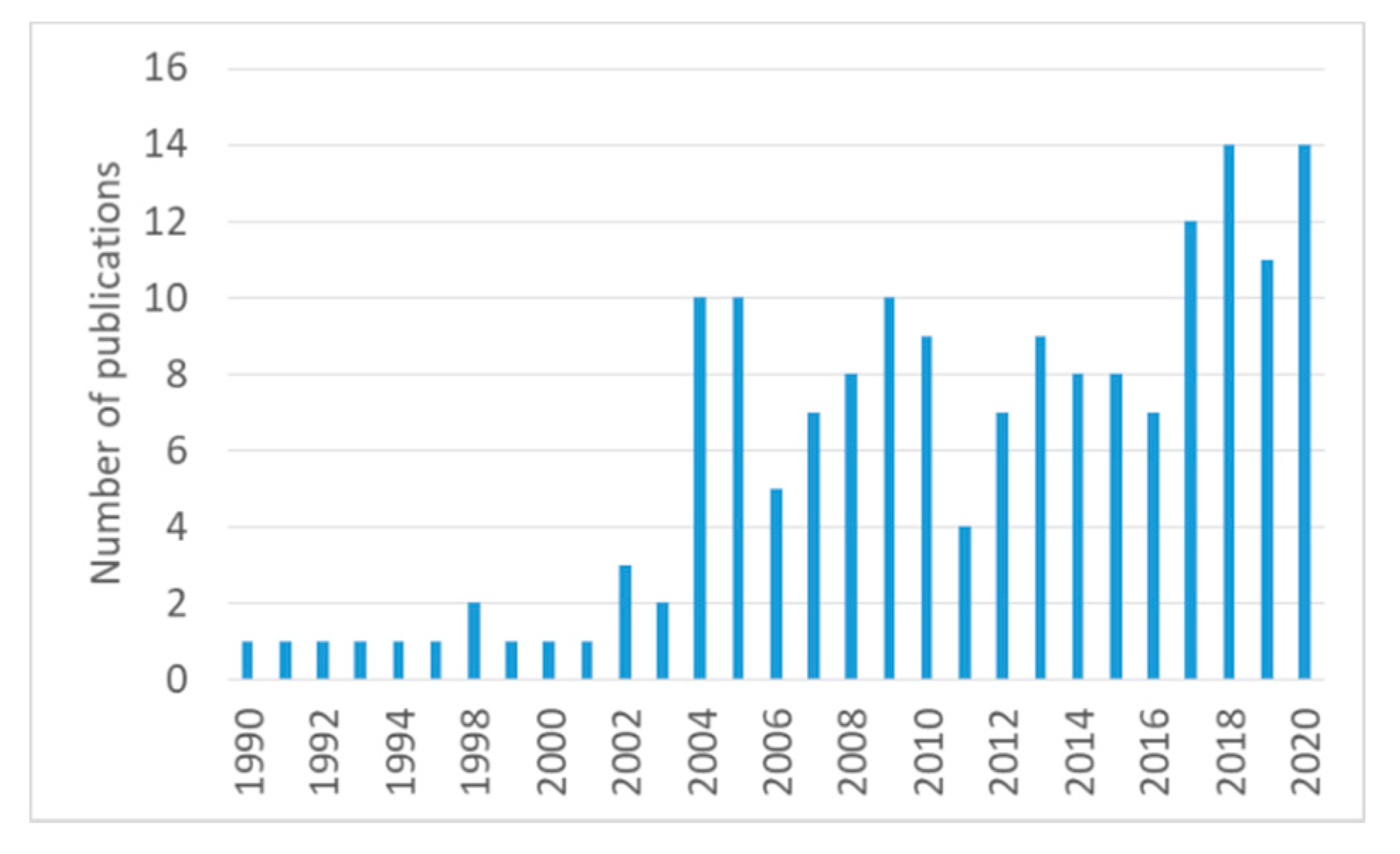
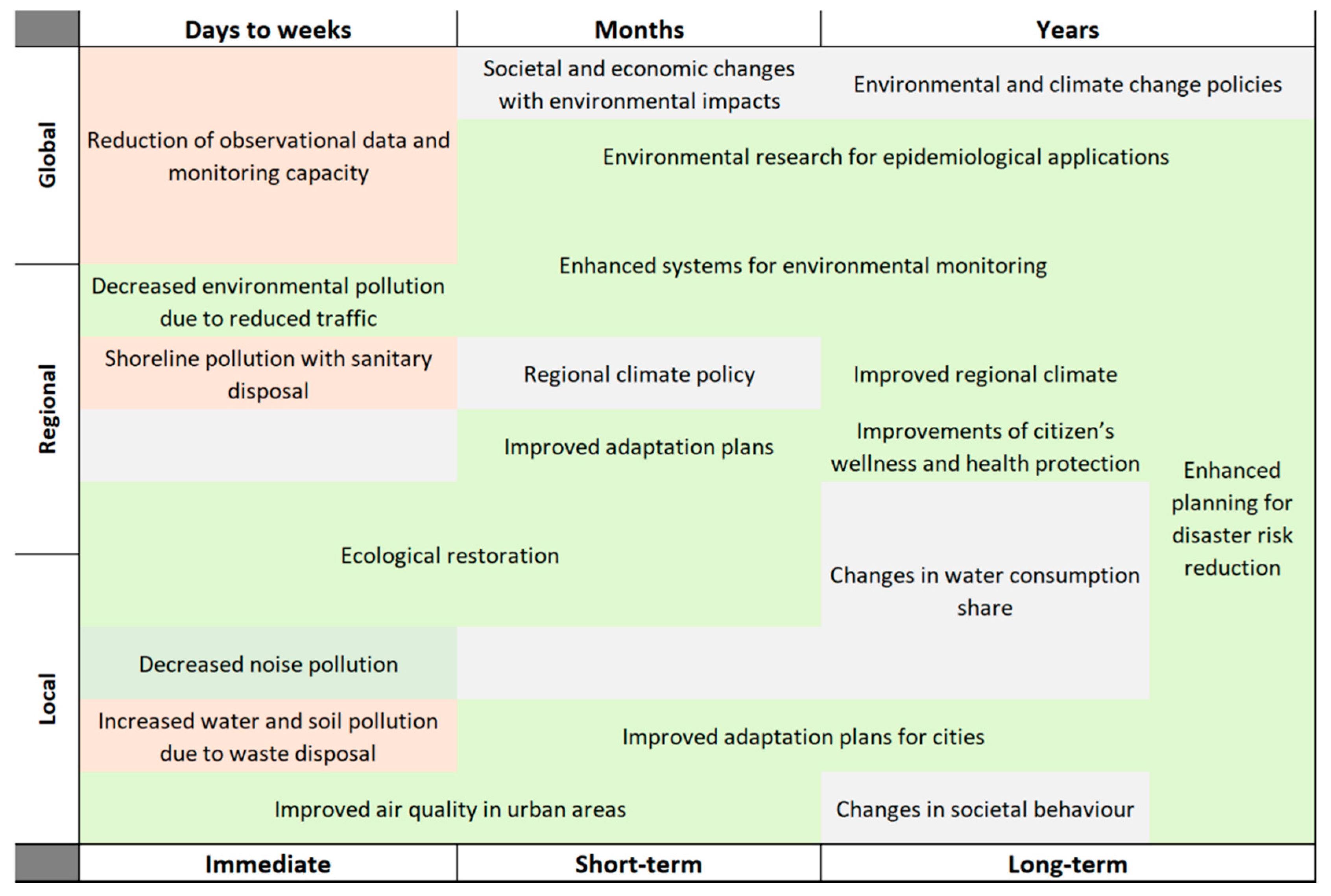
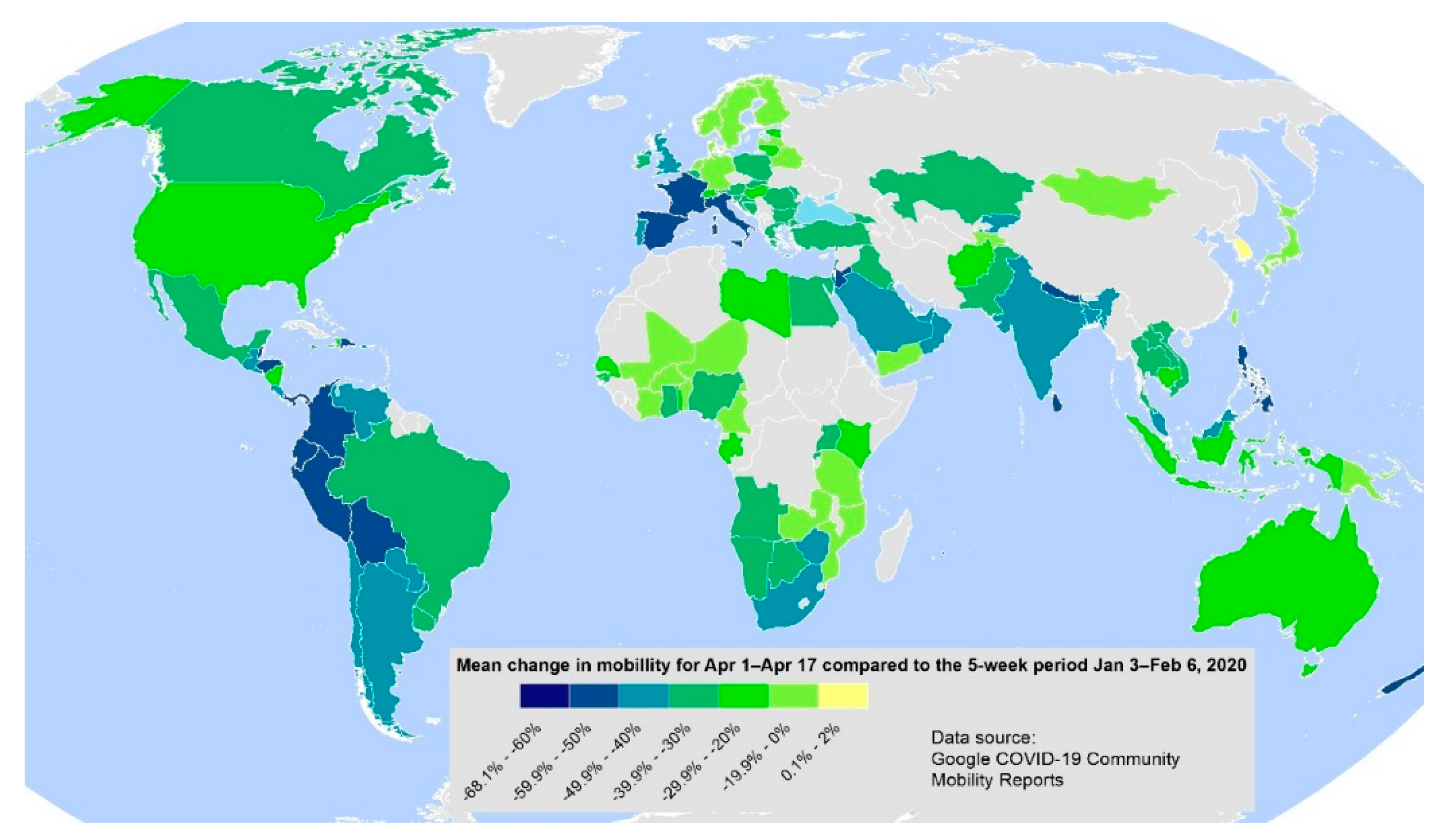
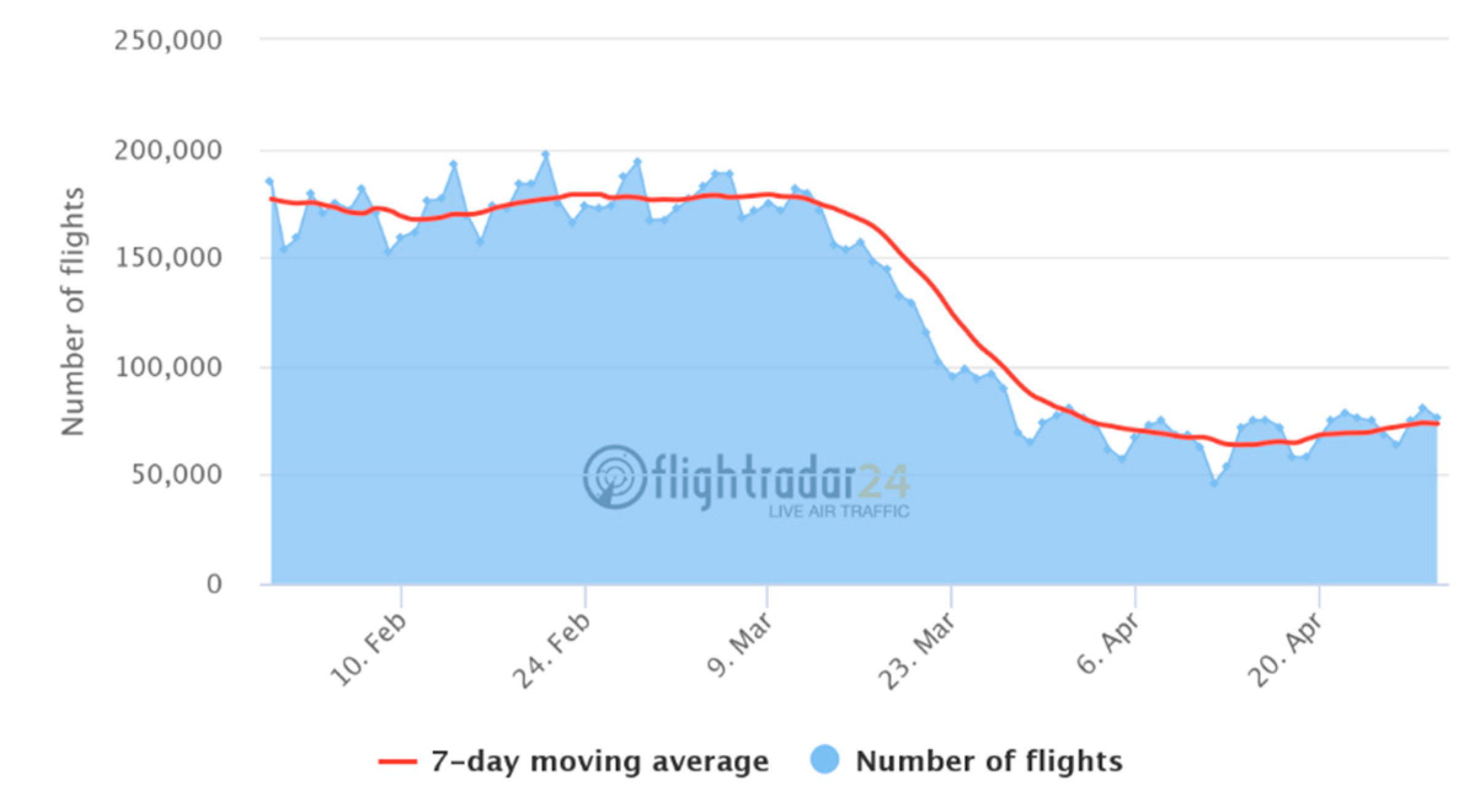
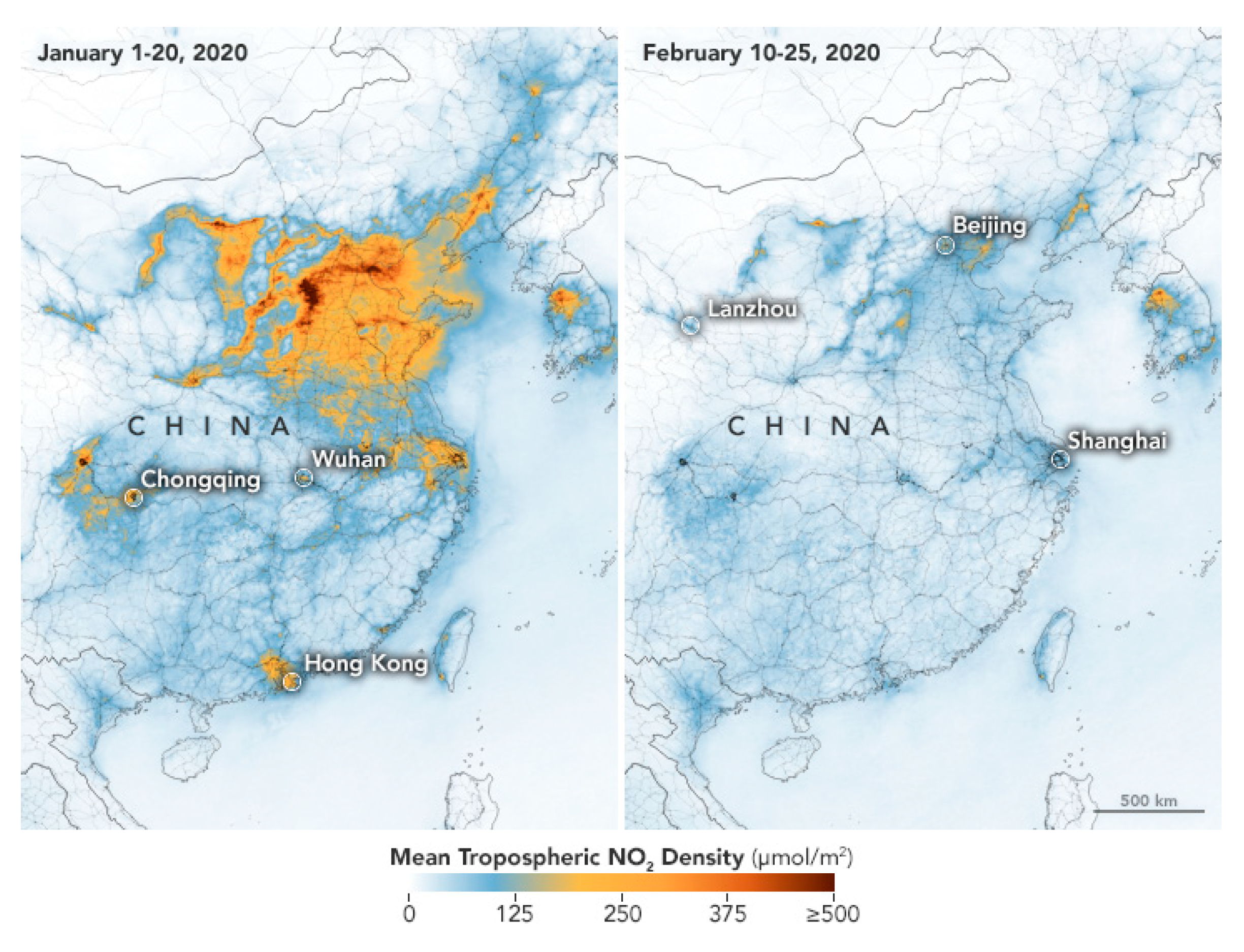

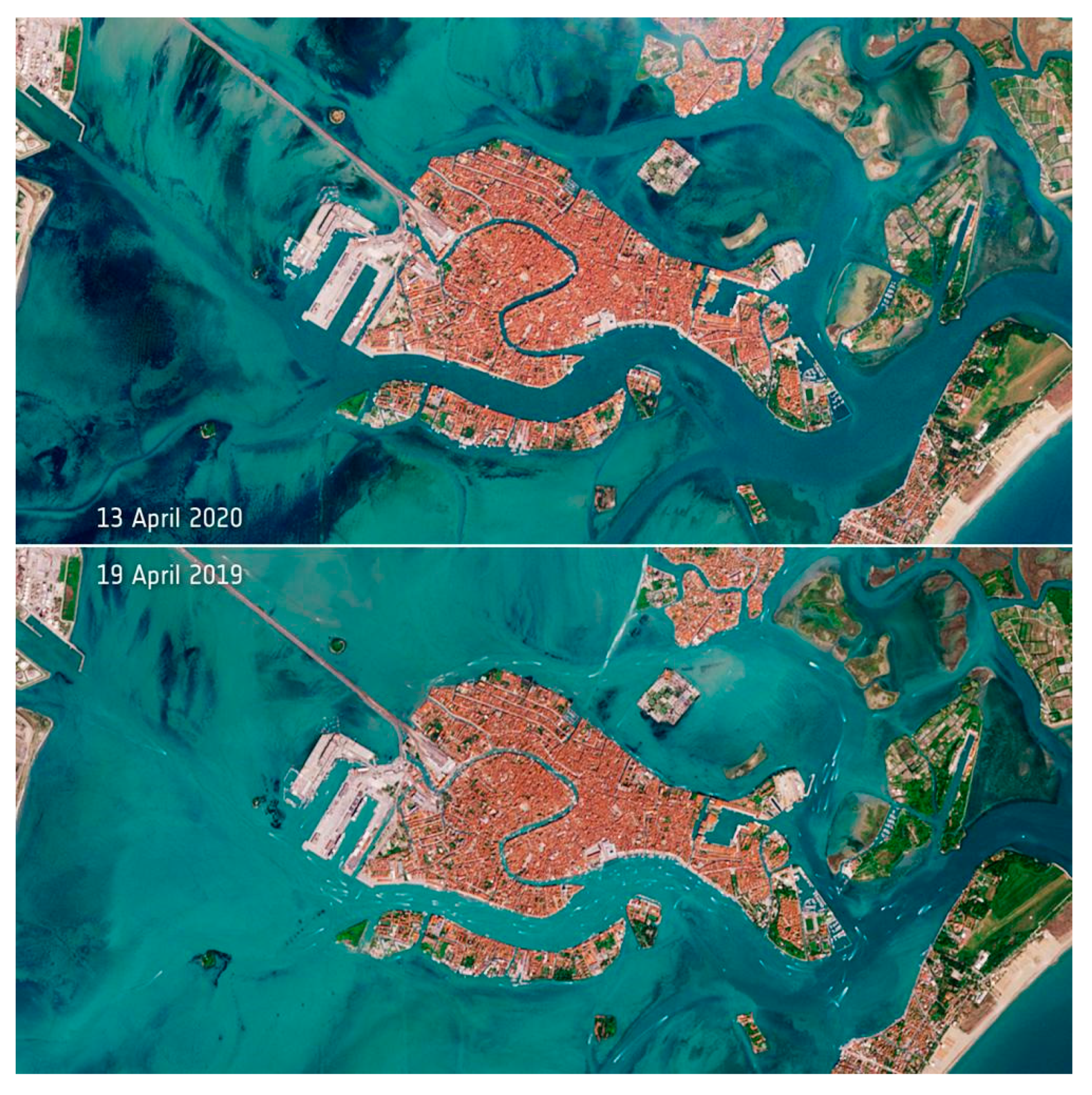
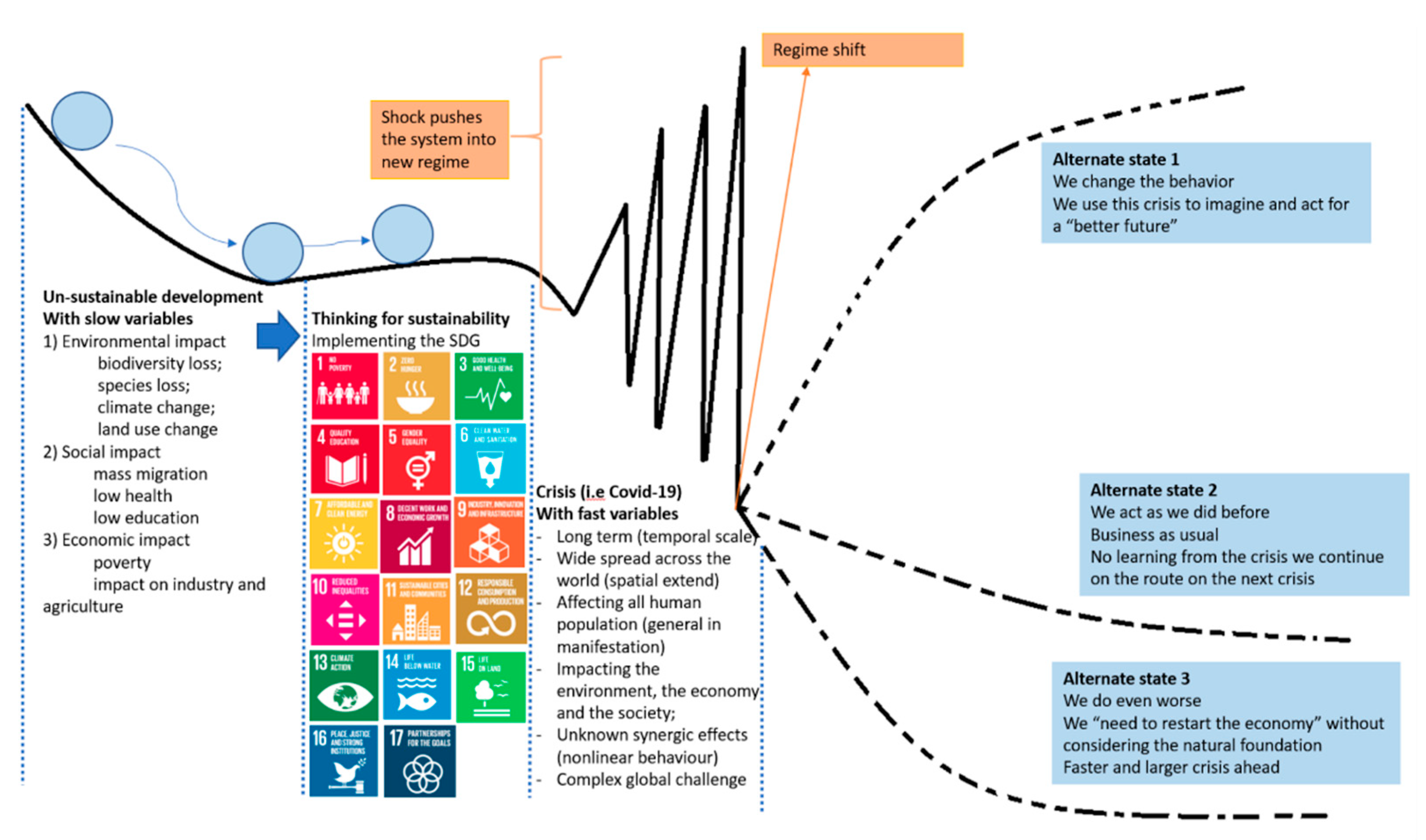
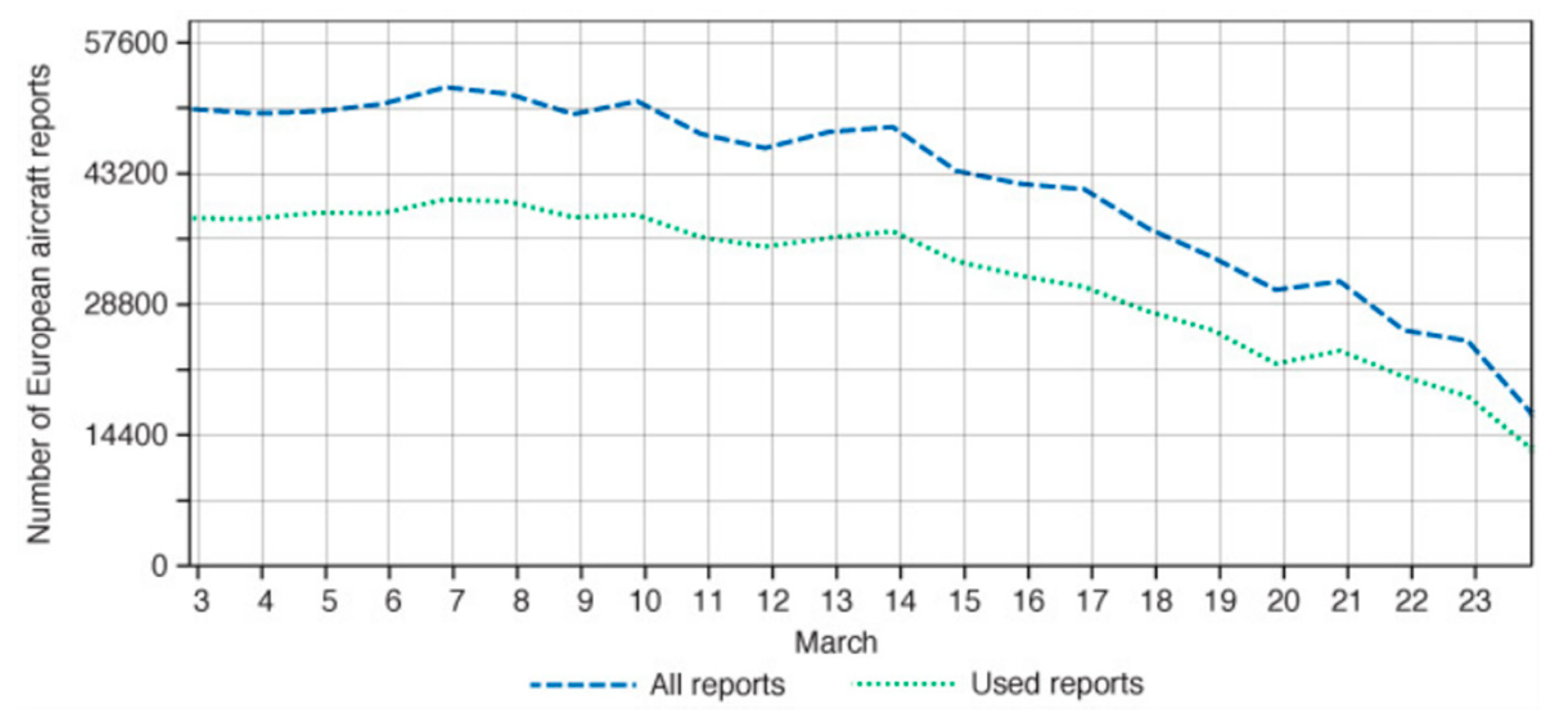
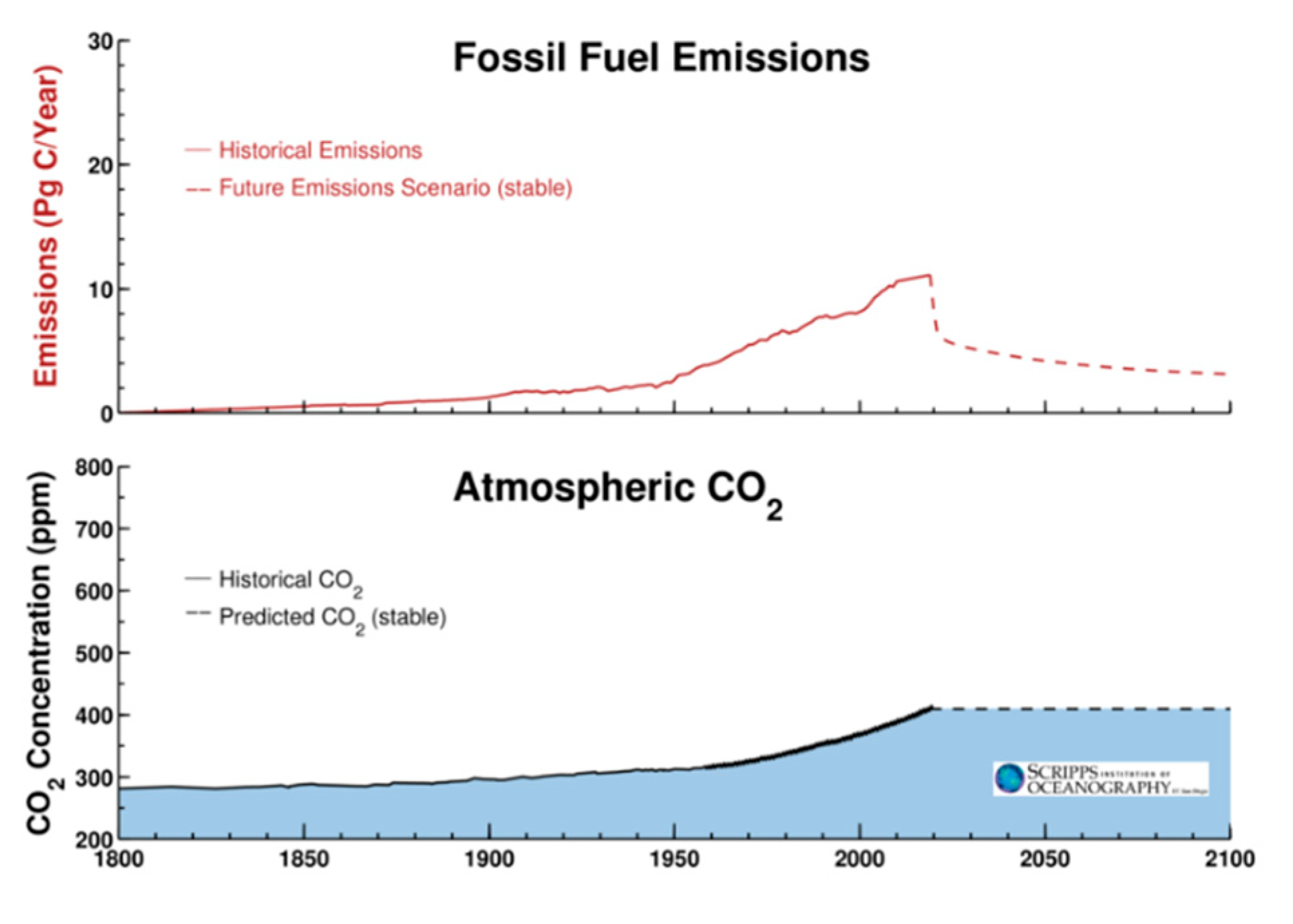
| SDGs | COVID-19 Observed and Potential Impacts (Examples) | Time Scales of the Impact | References |
|---|---|---|---|
| 1: No Poverty | Deep economic and financial crisis could dramatically increase extreme poverty. | Days to decades | [98] |
| 2: Zero Hunger | The crisis has caused a massive slowdown of the efforts to support investment, including through enhanced international cooperation. Impact on the Water, Energy and Food security nexus. | Days to decades | [2] |
| 3: Good Health and Well-being | Greater attention to the elderly and the fragile population for the growth of dedicated assistance services and access to medical and food resources. | Days to decades | [105] |
| 4: Quality Education | Education systems were forced to abruptly change procedures, shifting from physical to online teaching. | Days to decades | [106] |
| 5: Gender Equality | Pre-existing inequalities in the labour market have been deepened. | Days to years | [107,108] |
| 6: Clean Water and Sanitation | The discovery of the permanence of the virus on surfaces and in aquifers requires a revision of the purification and sanitation systems. | Days to years | [109] |
| 7: Affordable and Clean Energy | Alternative energy sources and backup storage and transport systems should be developed to secure societal needs during crises. | Years to decades | [110] |
| 8: Decent Work and Economic Growth | The pandemic has shown that there are groups of workers most exposed to risk to health and life by requiring a revision of the working methods in industry, commerce and health. | Months to decades | [105,111] |
| 9: Industry, Innovation and Infrastructure | Technological innovation and a close link with the research invention, also to the advantage of a change in production methods, has proved to be an unavoidable condition for the solution of global problems | Months to decades | [112,113] |
| 10: Reduced Inequality | Improvements in access to information technologies to reduce inequalities in poor and large families who have to use remote school systems and access to other resources. | Days to months | [24,114] |
| 11: Sustainable Cities and Communities | Revisions of adaptation plans are foreseen for major cities to increase health resilience in citizens and to better protect elderly population. | Months to decades | [72,115,116] |
| 12: Responsible Consumption and Production | Revision of production systems from the global to the local scale to ensure access and distribution of strategic resources with consequent enhancement of territorial activities. | Months to decades | [117] |
| 13: Climate Action | Transfer of the concepts learned from pandemic evolution to the climate issue. | Months to decades | [118] |
| 14: Life Below Water | No evidence of significant observed or potential impact. | Not the case | [119] |
| 15: Life on Land | Possible financial shortages on protected areas, Increase microplastics in water and soil; Strong support for closing the wildlife trade; Concerns about the influence of habitat loss on epidemic episodes. | Months to decades | [92,93] |
| 16: Peace and Justice Strong Institutions | The importance of strong coordination between institutions has been markedly indicated for national ones but, above all, for international ones where the exchange of exact and punctual information can indicate safe ways for solving problems on a global level. | Months to decades | [99,120] |
| 17: Partnerships to achieve the Goal | The efficiency of international agreements have been dramatically challenged, and the need for rethinking regional and global partnerships emerged. | Days to decades | [103] |
© 2020 by the authors. Licensee MDPI, Basel, Switzerland. This article is an open access article distributed under the terms and conditions of the Creative Commons Attribution (CC BY) license (http://creativecommons.org/licenses/by/4.0/).
Share and Cite
Cheval, S.; Mihai Adamescu, C.; Georgiadis, T.; Herrnegger, M.; Piticar, A.; Legates, D.R. Observed and Potential Impacts of the COVID-19 Pandemic on the Environment. Int. J. Environ. Res. Public Health 2020, 17, 4140. https://doi.org/10.3390/ijerph17114140
Cheval S, Mihai Adamescu C, Georgiadis T, Herrnegger M, Piticar A, Legates DR. Observed and Potential Impacts of the COVID-19 Pandemic on the Environment. International Journal of Environmental Research and Public Health. 2020; 17(11):4140. https://doi.org/10.3390/ijerph17114140
Chicago/Turabian StyleCheval, Sorin, Cristian Mihai Adamescu, Teodoro Georgiadis, Mathew Herrnegger, Adrian Piticar, and David R. Legates. 2020. "Observed and Potential Impacts of the COVID-19 Pandemic on the Environment" International Journal of Environmental Research and Public Health 17, no. 11: 4140. https://doi.org/10.3390/ijerph17114140
APA StyleCheval, S., Mihai Adamescu, C., Georgiadis, T., Herrnegger, M., Piticar, A., & Legates, D. R. (2020). Observed and Potential Impacts of the COVID-19 Pandemic on the Environment. International Journal of Environmental Research and Public Health, 17(11), 4140. https://doi.org/10.3390/ijerph17114140







